What Inspires Artist Sarah Fenwick?
In this blog post, read about cultivating creativity through gardening, art, and cooking. Artist Sarah Fenwick shares why gardening, art, and food are important to her and how one inspires the other. Discover helpful tips for cultivating vegetables and herbs in a compact container garden situated on Sarah’s balcony in Nicosia, Cyprus.
Cultivating creativity
“There are two ways to live: you can live as if nothing is a miracle; you can live as if everything is a miracle.”
Albert Einstein.
Nature’s miracles are all around us in rainbows, clouds, the sea, the earth, and the sun. These daily miracles are something I became more aware of after I took up gardening seriously in 2022. My purpose in writing this blog post is to share my inspirations with you and hopefully encourage your inner creative urges.
Gardening, art, and cooking food are part of what makes my daily life a miracle, with one activity inspiring the other with common elements of colour and creativity.
Plants grow largely unseen, we only notice their growth when they’re suddenly sprouting from seeds, growing new leaves, or flowering. Like a swan’s legs moving beneath the water to create the bird’s elegant gliding effect, much of the effort it takes to grow happens below the earth’s surface in a plant’s roots, unseen magical changes that transform a seed into a fully-grown flower or vegetable.
A piece of art germinates as a seed does, it hides somewhere in the subconscious or in my consciousness, growing unseen until it flows out on a surface through the paintbrush or pencil. Painting flowers and herbs from my garden has been an enjoyable way to practice rendering what I see around me. I lean toward the interpretive and expressionist school of painting, so my approach is to paint the energy and feeling of the leaves and stems rather than the strict botanical details. Sometimes, the vibrance of the greens in my garden is overwhelming.
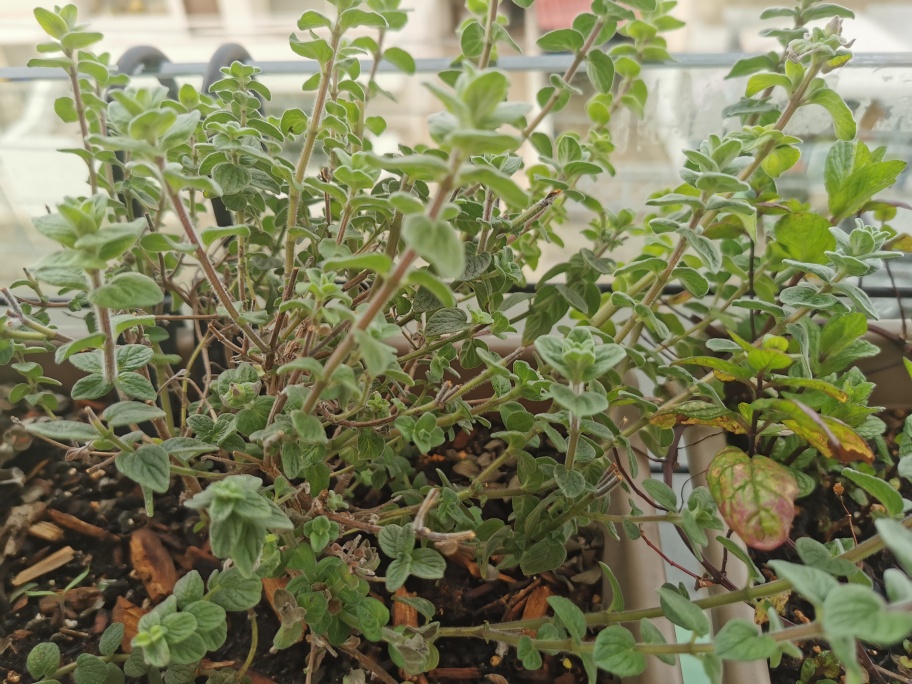
The herbs and vegetables in my container garden inspire different recipes through sense and taste and the vibrant colours awaken the appetite to cook.
The Garden
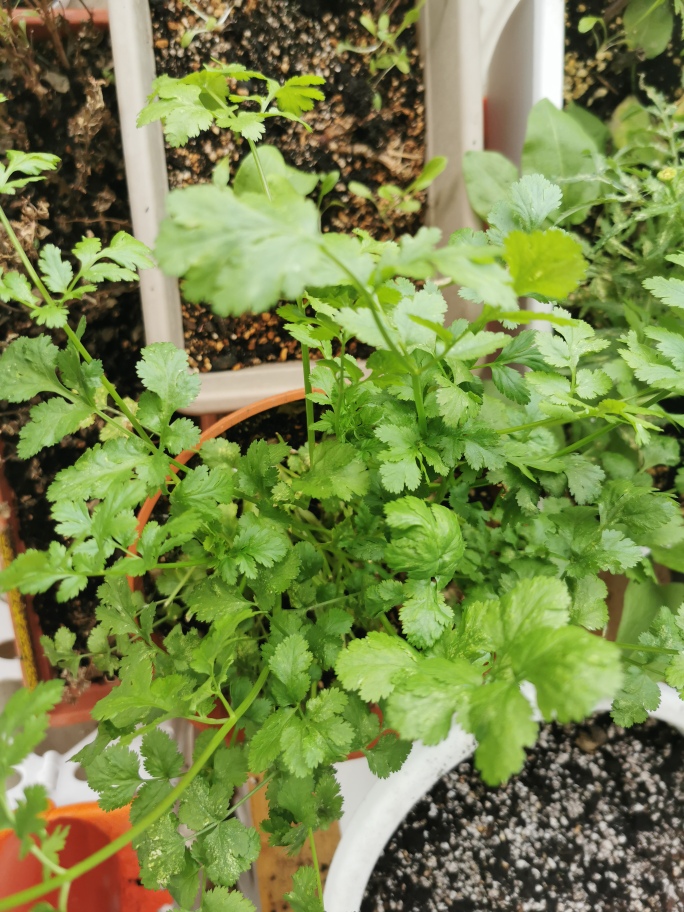
In 2022, I started gardening when I saw an avocado seed had sprouted inside the fruit and I suspended it in a glass of water to see what would happen. When it grew roots, I was hooked and watched as many tutorial videos as I could find. Three of my favourite gardening channels are MI Gardener, Charles Dowding and GrowVeg. I’m grateful for everything I’ve learned from their tips and tutorials, they’re real gardening experts.
I chose herbs, flowers, and vegetables that are adapted to Cyprus’ weather, sub-tropical Zone 11 with temperature extremes between high heat in summer and frost in winter.
From small beginnings grew a small garden on my balcony where I now raise lettuce, arugula (rokka), marigolds, radishes, oregano, mint, basil, spring onions, avocado trees, lemon trees, bougainvillea, cucumbers, roses, and scented geraniums. By and large, they grow successfully and I’ve learned not to let the failures get me down by remembering the abundance of nature and planting multiple seeds instead of just a few.
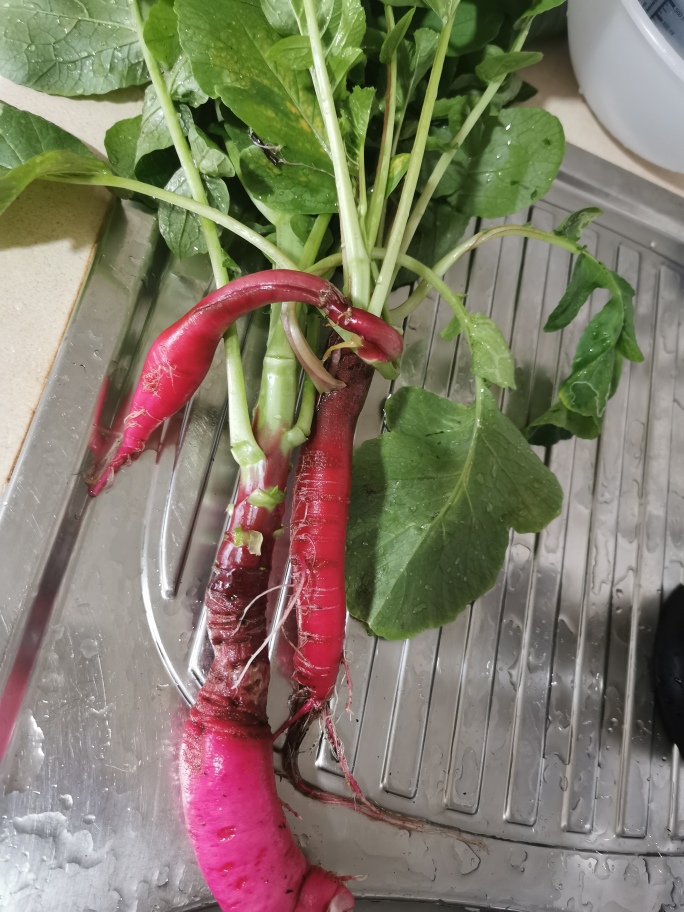
Yesterday I picked radishes that had been growing slowly through the winter and once spring set in, they suddenly ripened. It seemed sudden, but it was just because the radishes were growing cells slowly in the cooler weather, and when the weather warmed up, they were ready to ripen quickly.
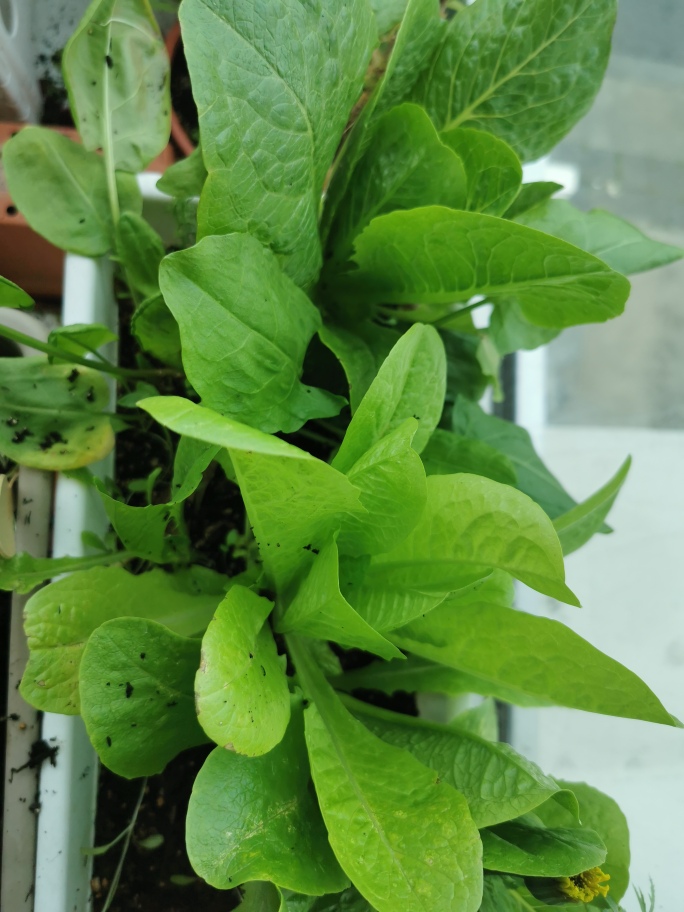
Like radishes, my lettuce also grew slowly through winter months, ripening quickly after March 1st, so if you’re a fan of having fresh vegetables in early spring, try the technique of planting seeds in late November so the plants are ready for a growth spurt in spring. This worked for me for onions, lettuce, marigolds, and radishes but not for potatoes and garlic, at least not this time around.
The Food
What you see below is my first-ever homegrown salad made with lettuce from my container garden. Freshly picked salad leaves have a vibrancy and spring to their taste, and after I mixed it with a garlic vinaigrette made with good olive oil, apple cider vinegar, and lemon, this was the most satisfying salad I’ve ever had. Now I understand why farm-to-table restaurants are so popular, it’s the freshness, straight out-of-the-ground way of eating that has a kind of immediacy bringing us closer to the origin of our food.
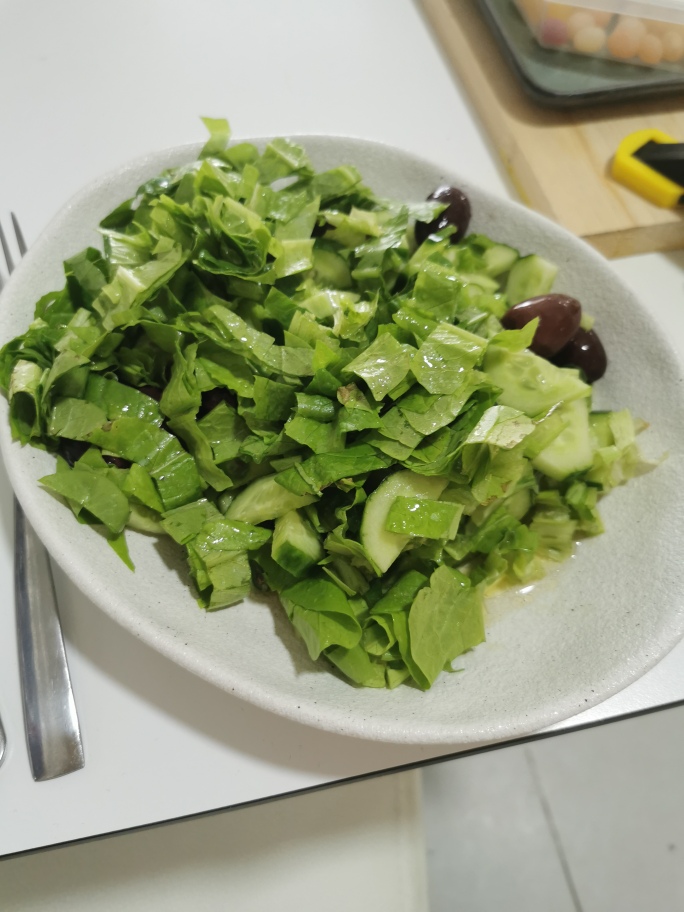
Lettuce, Cucumber, and Kalamata Olives Salad
Fresh lettuce leaves, sliced medium thin.
3 cucumbers, sliced in half and then sliced into medium-thin pieces.
Large black Kalamata olives.
For the dressing:
Four tablespoons of good olive oil.
1 tablespoon of apple cider vinegar.
1 teaspoon fresh lemon juice.
1 clove of fresh garlic, grated into a fine paste.
Add salt and pepper and dry or fresh oregano leaves to taste.
Try this salad with my recipe for homemade breadsticks
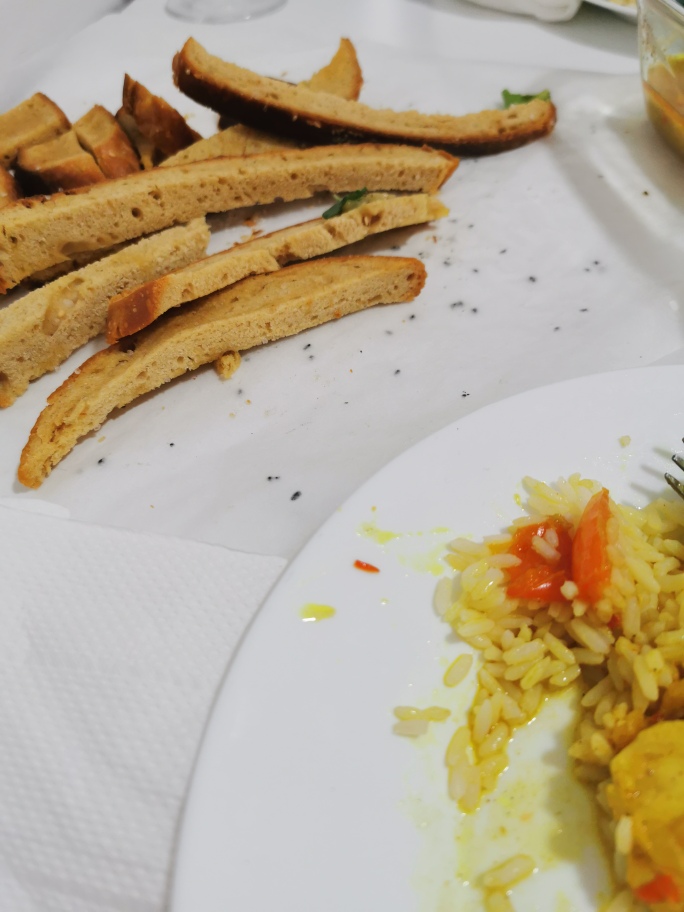
Oregano Garlic Breadsticks
For the bread:
650 ml tepid water mixed with a package of dry yeast and a pinch of sugar.
Add 1kg of flour, salt, and dry oregano, mix, and knead until smooth. Cover and leave to rest for 1 hour in a warm place.
Punch down the dough and let it rest for another 30 minutes. Bake at 200 degrees Celsius for 35 to 40 minutes until golden.
Once it’s cooled, slice into medium size pieces and slice those lengthways. Bake at 100 degrees Celsius for 1 hour and 15 minutes for crunchy delicious breadsticks.
For the garlic topping:
Slice off the top 1 cm off a clove of garlic and drizzle with olive oil and sea salt. Roast at 100 degrees Celsius with the breadsticks. Remove the garlic casing and crush the cloves with some olive oil and apple cider vinegar. Add salt and pepper to taste and top the breadsticks with this potent punch of flavour.
The Art
When it comes to art and gardening, it’s all about the colours that leap out at me when the light is at a certain angle, capturing my attention. Different light effects like luminescent green when the light shines through a delicate leaf and vibrant shades of violet and magenta in bougainvillea leaves plant ideas for a painting into my consciousness. I’m constantly tracing the curves of flower and herb stems in my visual memory, knowing they’ll help to guide my hand when I next pick up a paintbrush.
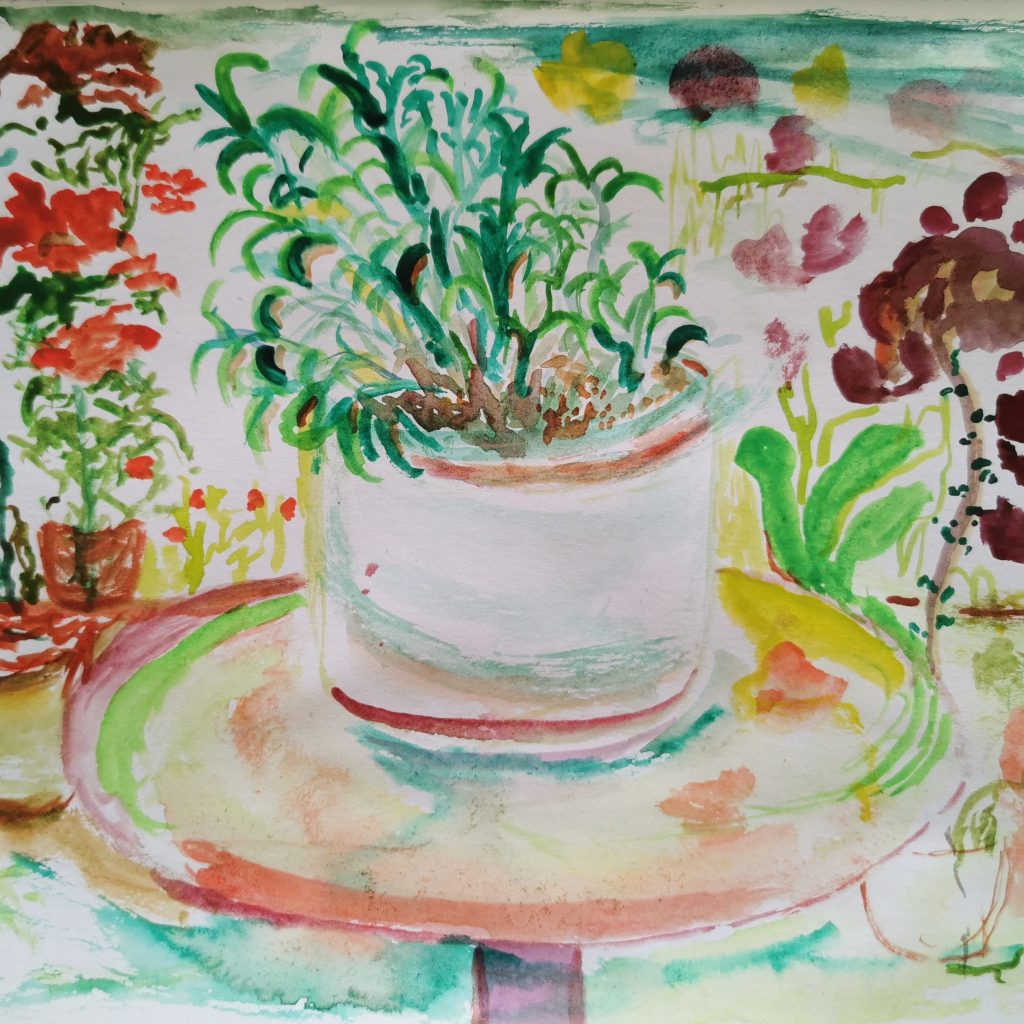
This piece is titled ‘Rosemary’ and is a quick watercolour painting in my sketchbook of a plant I love to grow and use in cooking. When I painted it, I noticed the leaves changed colour from the dark green sage grey of older leaves to the lighter, fresher green of the younger leaves. Like many other artists, I’m inspired by nature’s colours and learning how plants grow helps guide the shapes and lines of my paintings. Rosemary, for example, has quite rigid stems that later become woody, ending up in straighter lines that look great contrasted with the curvy leaf shapes.
Tips for combining art and gardening
- Observe colours and light effects to get ideas.
- Draw or sketch studies of leaves and flower petals.
- Replicate different colours in paint to practice colour theory.
- Feel inspired by the sheer variety and abundance of nature.
I hope my journey as an artist reveals how creativity can be cultivated in so many ways. Gardening, art, and cooking are aspects of my creative process. I’ve explored the beauty of the natural world through gardening, used art to express myself, and enhanced my creative endeavors with the flavors of fresh herbs straight from the garden. The tips I’ve shared in this blog post will help you cultivate creativity by taking inspiration from three different activities and trying them for yourself.
Whether you’re interested in gardening, art, or cooking, this blog post has shown that creativity can be found in all aspects of life.
FAQ About Sarah Fenwick Artist
Q: What kind of art does Sarah Fenwick create?
A: Sarah Fenwick is a diverse and highly skilled artist, working in a variety of mediums and styles. Her work ranges from abstract expressionism to abstract realism and from painting to singing. She’s always exploring new mediums and techniques to create unique and beautiful works of art.
Q: Where can I find Sarah Fenwick’s art?
A: A collection of Sarah Fenwick’s paintings can be found on her website www.sarahfenwickart.com. Her work is in private collections in different countries and online on art websites like SaatchiArt.com. Visit her website to learn more about her work and to purchase prints, originals, and other products featuring her art.
Q: What inspires Sarah Fenwick’s art?
A: Sarah Fenwick draws inspiration from a wide range of sources, from the beauty of nature to the power of music. She also draws from her own life experiences, channeling her emotions into her artworks. Sarah’s artwork is both personal and universal, reflecting metaphysical, spiritual, musical, and mystical themes.
Learn more about artist Sarah Fenwick.
Originally published on CyprusNewsReport.com.